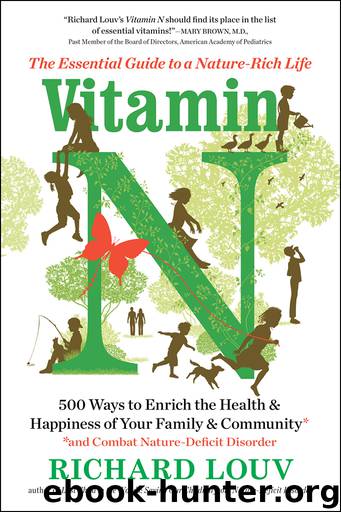Vitamin N by Richard Louv

Author:Richard Louv [Richard Louv]
Language: eng
Format: epub
Publisher: Algonquin Books
Published: 2016-01-01T05:00:00+00:00
Get Wet and Wetter
Learn to swim.
A surprising number of children never learn to swim. The Ocean Discovery Institute in San Diego found that 90 percent of inner-city children did not know how to swim, 95 percent had never been in a boat, and 34 percent had never even been to the ocean, despite the Pacific being only minutes away. Public swimming pools are a great place to start; they’re controlled environments, usually with lifeguards on duty, and swimming instruction programs. Lakes, ponds, and the ocean are free alternatives, but watch out for unpredictable depths, jagged rocks, broken glass, and, in the case of the beach, riptides and dangerously high surf. Start slowly, with flotation devices. And remember, despite the risk at the front end, learning to swim is a basic safety requirement for life. For the more adventurous, snorkeling and scuba diving open up new worlds. SwimLessons.com can guide you to swimming schools and instructors. Or visit a community YMCA.
Sail away.
Any activity close to water ignites the natural senses. In terms of connecting to nature, boating can cut both ways. On lakes or seas, motorboats put us in contact with fish, whales, snakes, waterbirds, and humbling weather. But a proviso: high-decibel, highspeed boating can also be a barrier between people and nature, and not only for the people on the boat. Sailing is a quieter option. For general information, see SailingWithKids.net. To learn about accessible sailing, see DisabledSportsUSA.org.
Go surfing or paddling.
If you Google “surfing,” most of the hits are about surfing the web. Still, reality-based surfing survives and even thrives. Kids can learn early; adults anytime. Take your kids boogie boarding or skim boarding. Go canoeing or kayaking on salt water or freshwater. Or try paddle boarding: imagine a big surfboard that you stand on and propel yourself with a canoe paddle. Some people fish or photograph from paddleboards, and from surfboards, kayaks, and, of course, canoes, too. Suggested books: Surf’s Up: The Girl’s Guide to Surfing; Surfer’s Start-Up; Kayaking Made Easy; and Basic Canoeing.
Experience rafting on whitewater rivers or quieter waters.
Whether you purchase your own raft (and safety equipment) or rent, river rafting is guaranteed to be memorable. Start in easy water—slow moving, no rapids, no major obstacles—and work up from there. Bring squirt guns and waterproof nature guides. The website of Colorado Rafting shares tips for taking a child whitewater rafting. Unless you are experienced, go whitewater rafting with a reputable service, not alone. Or, MotherEarthNews.com provides instructions for building a DIY raft, Huck Finn style, preferably for use on a lake, pond, or slow, shallow stream. Suggested books: Whitewater Rafting: The Essential Guide to Equipment and Techniques and Whitewater Safety and Rescue.
Download
This site does not store any files on its server. We only index and link to content provided by other sites. Please contact the content providers to delete copyright contents if any and email us, we'll remove relevant links or contents immediately.
Letter to My Daughter by Maya Angelou(1678)
Dog Training 101 by Kyra Sundance(1507)
The Whole Lesbian Sex Book by Felice Newman(1383)
The Pizza Party by Theo Baker(1323)
The Unofficial Guide to Walt Disney World with Kids 2017 by Bob Sehlinger(1206)
Art Lab for Little Kids (Lab Series) by Susan Schwake(1172)
Talking with Your Toddler by Teresa Laikko(1085)
Playful Parenting by Cohen Lawrence J(1077)
Encyclopedia of Infant and Toddler Activities by Kathy Charner(1059)
Circus by unknow(1052)
The Budding Chef by Kate Kuhn(1049)
Welding for Dummies by Welding(1021)
The Big Book of Nature Activities by Jacob Rodenburg(997)
Zen Mind, Beginners Mind by Shunryu Suzuki(992)
The Creative Family Manifesto by Amanda Blake Soule(971)
An XL Life by Big Boy(964)
The Sense of Wonder by Rachel Carson(960)
Photographing Families by Unknown(948)
Four Great Americans: Washington, Franklin, Webster, and Lincoln (Yesterday's Classics) by Baldwin James(912)
